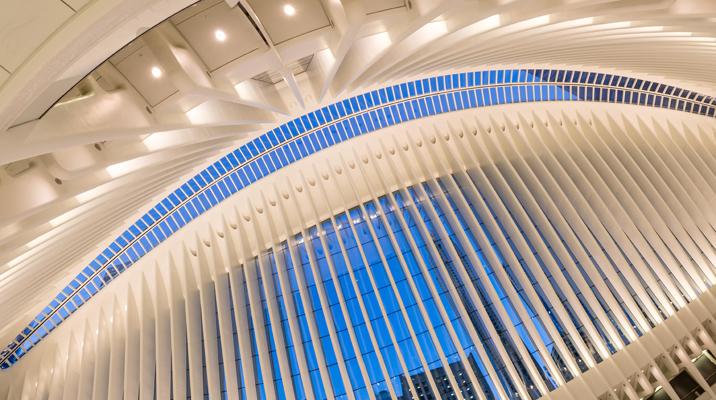The Oculus: New York's New Landmark

There are few sites in the world that are as loaded with memory, grief, identity, pride and loss as New York's World Trade Center.
Although plans to commemorate the lives lost and reconstruct the buildings destroyed on 11th September 2001 began almost immediately, it has taken a long 14 and a half years to complete one of the most critical components, the World Trade Center Transportation Hub. The original station was destroyed by the collapse of the Twin Towers and a temporary replacement opened two years later.
Designed by the acclaimed engineer and architect Santiago Calatrava, the new Transportation Hub sits alongside the National September 11 Memorial Plaza and museum, one of the most visited spots in New York. The station is remarkable for several reasons, not least its bold and inspiring design. Typical of the Spanish designer's oeuvre, it was also expensive and complex to construct. Regardless of the length of the process, however, the end result has achieved the aim of creating a new focal point for this important site.
Allegedly inspired by a bird flying from a child's outstretched hand, the Oculus itself is a masterpiece of complexity.
Calatrava's highly symbolic design language has been deployed to maximum effect. The key structure is the Oculus - a ribbed, soaring steel-and-glass pavilion that forms the station's centrepiece and stands above its spectacular main concourse. Allegedly inspired by a bird flying from a child's outstretched hand, the Oculus itself is a masterpiece of complexity: an oval arrangement of ribs fanning out from a 330ft central spine to create twin fluted curves. These stand in stark and delicate contrast to the vast, glass-sided canyons created by the Center's clutch of new skyscrapers. The numbers are big - the steel alone cost around US$474m, and well over a billion dollars has been devoted to the tricky logistics of working at the heart of one of the country's largest building sites.
There have been other issues, too. For budgetary reasons, Calatrava's original design was scaled down - those ribs were initially intended to move gracefully and open up the space - yet infrastructure problems, unforeseen difficulties, and planning and security issues still meant costs rose considerably. The final sum, US$4bn, has been much discussed in the media. Building the aforementioned infrastructure is expensive, and the Oculus itself is simply the most visible element of a huge complex that stretches deep below ground and intersects with six subway lines. The end result will serve the city well and become a key destination in its own right. The opening of the new Westfield World Trade Center - a multi-level subterranean mall with the Oculus at its heart - marks another transformation. From the outset, Calatrava intended his building to be a beacon - extravagant, elaborate and delightful. And that is precisely what he has delivered.
Picture credit: Alamy



